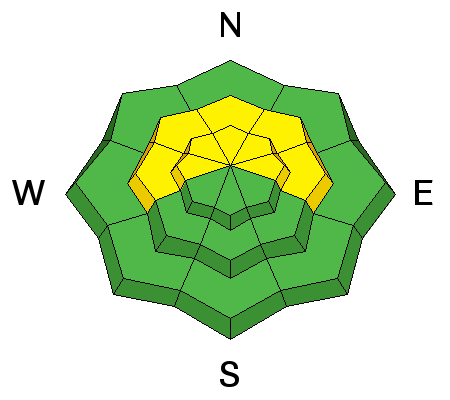| Please join us at the 23rd annual Black Diamond Fall Fundraiser Party Thursday Sept 15. Tickets are on sale now here, at the Black Diamond store & at REI. Special bonus raffle for online ticket purchasers! |  |

| Please join us at the 23rd annual Black Diamond Fall Fundraiser Party Thursday Sept 15. Tickets are on sale now here, at the Black Diamond store & at REI. Special bonus raffle for online ticket purchasers! |  |
| Advisory: Salt Lake Area Mountains | Issued by Brett Kobernik for Wednesday - December 30, 2015 - 5:57am |
|---|
 |
special announcement Come join the Utah Avalanche Center and Alta Ski Patrol for a free 1-hour Know Before You Go avalanche awareness presentation and discussion about current avalanche conditions. Talk starts at 6:00pm at the Our Lady of Snows Center. Presented in memory of Bryce Astle and Ronnie Berlack #goodvibesonly |
 |
current conditions A trace to a couple inches of very low density snow fell over the last 24 hours. Temperatures remain cool. Readings in the higher terrain are in the single digits and in the low teens in the mid elevations. Westerly wind has been and remains fairly light in speed. Riding conditions are excellent on a variety of aspects in the mid and lower elevations. Higher terrain has seen some damage from wind a few days back. |
| type | aspect/elevation | characteristics |
|---|


|


|

LIKELIHOOD
 LIKELY
UNLIKELY
SIZE
 LARGE
SMALL
TREND
 INCREASING DANGER
SAME
DECREASING DANGER
|
|
description
The million dollar question: Is it stable yet? You won't like my answer. I don't like my answer. Some places, yes, it's stable, some places, no, you could take a ride. Here's the set up. The weak early season snow has adjusted to the large December snow storms but it still exists down there. The December storms have formed a stiff "bridge" over the weak snow. Suspect terrain: West, north and east facing slopes over 35 degrees with a shallower overall snowpack (less than around 3' total depth). These areas have a thinner "bridge". These areas also have less snow on top of the old weak snow so the old weak snow is not getting compressed and bonding as fast. Terrain with better odds: Slopes less steep than 35 degrees as well as areas with a deeper snowpack. To create an avalanche, I think you need to have a slope with at least a 35 degree slope angle right now. Areas with a deeper snowpack have a thicker and stronger bridge. The additional weight of the deep snowpack also helps to physically compress the old weak snow and make it bond and strengthen, although this is a slow process. Many savvy folks are choosing steeper terrain that has avalanched over the last week. There is not a huge load sitting on weak faceted snow in these areas. Disclaimer: These are tricky conditions. Obvious signs of instability like collapsing and cracking are absent. Tracks on a slope don't indicate it's stable. Analyzing snowpack structure between "shallow weak" areas and "deep strong" areas is difficult for even seasoned veterans. Determining whether a slope has avalanched already can be difficult as well. Personally, I don't like trusting my life on a "bridge" that may break. |
 |
weather We'll have another fairly cool day with light snowfall here and there. Temperatures will remain in the teens and skies will be mostly cloudy. Westerly wind will remain fairly light. It looks like pretty nice weather through the weekend but temperatures do remain a bit cool. There are some storms on the horizon for next week but they look like they'll be to our south for the most part. |
| general announcements Remember your information can save lives. If you see anything we should know about, please participate in the creation of our own community avalanche advisory by submitting snow and avalanche conditions. You can also call us at 801-524-5304, email by clicking HERE, or include #utavy in your tweet or Instagram. To get help in an emergency (to launch a rescue) in the Wasatch, call 911. Be prepared to give your GPS coordinates or the run name. Dispatchers have a copy of the Wasatch Backcountry Ski map. Backcountry Emergencies. It outlines your step-by-step method in the event of a winter backcountry incident. If you trigger an avalanche in the backcountry, but no one is hurt and you do not need assistance, please notify the nearest ski area dispatch to avoid a needless response by rescue teams. Thanks. Salt Lake and Park City – Alta Central (801-742-2033), Canyons Resort/PCMR Dispatch (435)615-1911 Snowbasin Resort Dispatch (801-620-1017), Powder Mountain Dispatch (801-745-3772 x 123). Sundance Dispatch (801-223-4150) EMAIL ADVISORY If you would like to get the daily advisory by email you will need to subscribe here. DAWN PATROL Hotline updated daily by 5-530am - 888-999-4019 option 8. Twitter Updates for your mobile phone - DETAILS UDOT canyon closures: LINK TO UDOT, or on Twitter, follow @UDOTavy, @CanyonAlerts or @AltaCentral Utah Avalanche Center mobile app - Get your advisory on your iPhone along with great navigation and rescue tools. Powderbird Helicopter Skiing - Blog/itinerary for the day Lost or Found something in the backcountry? - http://nolofo.com/ To those skinning uphill at resorts: it is your responsibility to know the resort policy on uphill travel. You can see the uphill travel policy for each resort here. IMPORTANT: Before skinning or hiking at a resort under new snow conditions, check in with Ski Patrol. Resorts can restrict or cut off access if incompatible with control and grooming operations. Benefit the Utah Avalanche Center when you shop from Backcountry.com or REI: Click this link for Backcountry.com or this link to REI, shop, and they will donate a percent of your purchase price to the UAC. Both offer free shipping (with some conditions) so this costs you nothing! Benefit the Utah Avalanche Center when you buy or sell on ebay - set the Utah Avalanche Center as a favorite non-profit in your ebay account here and click on ebay gives when you buy or sell. You can choose to have your seller fees donated to the UAC, which doesn't cost you a penny. This information does not apply to developed ski areas or highways where avalanche control is normally done. This advisory is from the U.S.D.A. Forest Service, which is solely responsible for its content. This advisory describes general avalanche conditions and local variations always exist. |
Advisory Hotline: (888) 999-4019 | Contact Information